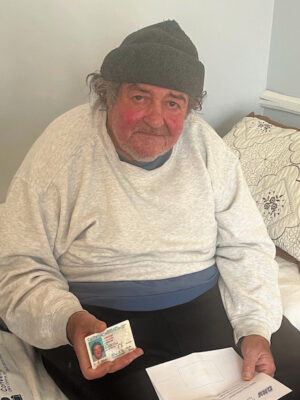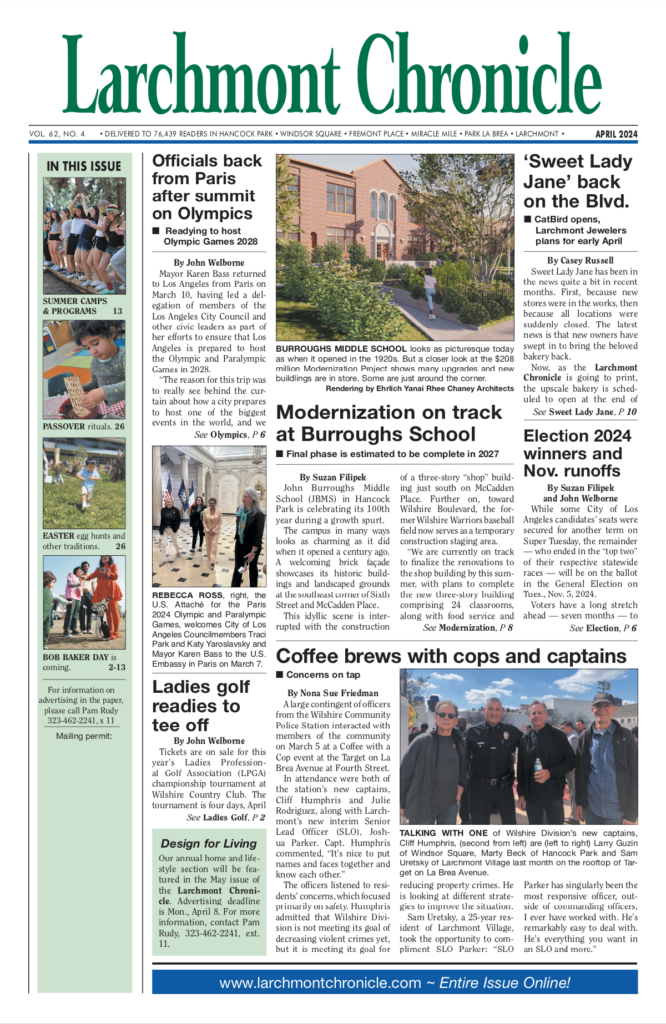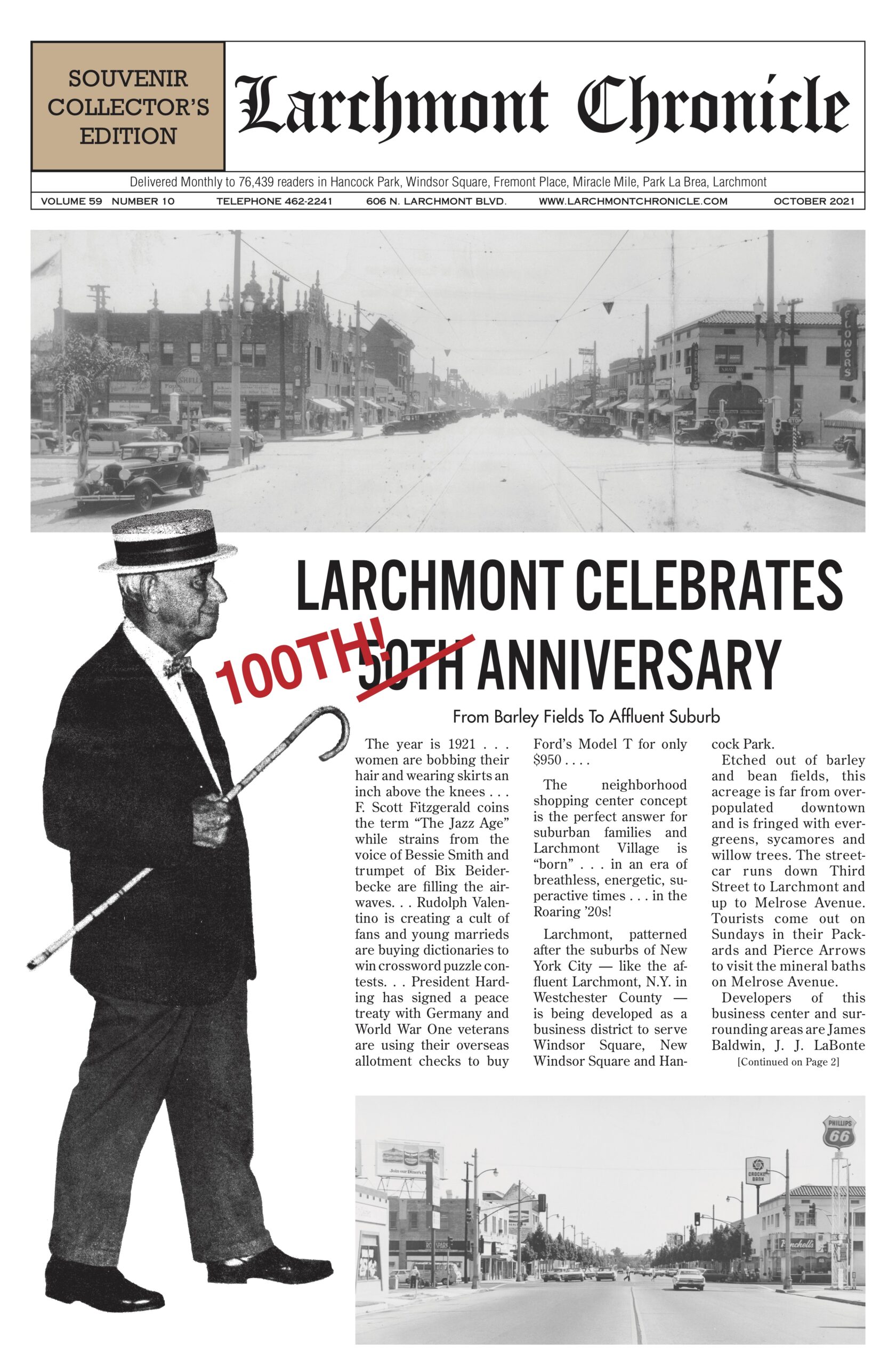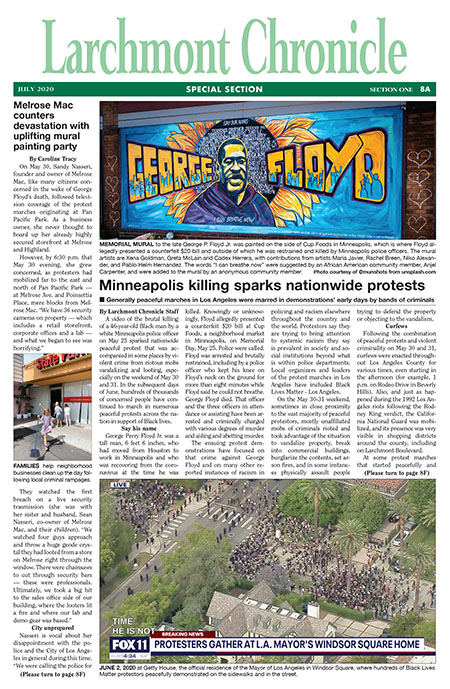Navigating the transition: homeless to housed

FRANCO, in his senior care facility bedroom, shows his new State ID.
Last in a series
“What do you really want?” I asked Franco Iervolino, formerly known as Giorgio when he and his possession-packed shopping cart were seen daily on Larchmont Boulevard, waiting for a gift of coffee or a sandwich.
We were sitting in his shared bedroom at the senior care facility where he now lives, after he was taken from the street on Larchmont to a mental health hospital on April 20 and then transferred here in July.
So what does he want? He answered without hesitation. “Money in my pocket and an apartment.”
Homeless just seven months ago, will Franco get his wish? Or will the system fail him while he waits in a dreary senior living facility subsisting on hamburgers and cigarettes?
Takes a team
Ending homelessness for just one person or family takes a team of volunteers and professionals, an enormous amount of money, adequate housing options and an unlimited number of hours in the day. One can’t pluck someone off a bus bench and fix everything by handing him or her a key to an apartment, assuming housing is even available.
Homelessness was on the ballot in November’s midterm elections, and virtually every candidate, no matter the office sought, pointed to solving homelessness as the biggest challenge we face. Given that the 2022 Los Angeles County Homeless Count found 69,144 unhoused people in Los Angeles County and 41,980 in the City of Los Angeles alone, it’s no wonder that politicos and voters alike want to fix what has become a crisis in our midst.
Housing vs. services
Almost everyone points to building more housing as step one: new supportive housing, large shelters, adapted shipping containers as homes, affordable housing as a percentage of new developments, converting hotels, filling unused hotel rooms with those in need, tiny home villages, dividing single-family property into multiple-family parcels, increasing density near transit hubs. The biggest differences among proposals is how many units they promise to construct, how quickly they can build them and for how much money.
Marilyn Wells, founder of Stories from the Frontline and guest columnist writing “The NIMBY Diaries” in 2021 for the Larchmont Chronicle, firmly believes the essential first step is for a community to commit to rectifying our severe shortage of affordable housing, explaining, “Anytime there is a shortage, demand increases, and many of our neighbors, such as essential workers and seniors on fixed incomes, can’t afford rent increases. It is that simple for a large part of our homeless population.”
According to Wells, organizations working on homeless outreach have concluded that 30 percent of homeless individuals have mental health or addiction problems. Other estimates are far higher.
Matthew Byrne, the Supervising District Attorney in the Hollywood Mental Health Court, thinks the actual number is closer to 75 percent, since the lower number is based on self-reporting. “Do you think you have a mental illness?” might not be the most accurate means of ascertaining the percentage of the homeless population that need mental health treatment.
Although Byrne agrees that “We need more beds,” he’s equally concerned about getting medical and mental health treatment to all in need. He notes the use of 18-wheel trucks or vans in some cities that deliver street psychiatry and medical care to those who are unhoused. However, he is especially troubled by the widespread use of methamphetamines on the streets. He questions whether treatment for meth addiction or psychosis can be effective for someone whose bed is the sidewalk.
Housing vs. autonomy
It is a bit of a miracle when a homeless individual gets the help needed to leave the streets, but even when that process is successful, there’s much more work to be done — and that work is very, very difficult to navigate.
Back to Franco
Franco Iervolino is one of the lucky ones.
At least, many of us assume he is lucky to have been taken off the street, diagnosed, treated, assigned a conservator and placed in a senior care facility in the Fairfax area.
However, there are those who argue that it is grievously wrong to take away a person’s right to choose his or her own path, even if that choice is to struggle on the street without a steady source of food, shelter and mental health or drug addiction help. Others maintain the contrary position — that it’s cruel not to do everything possible to help those who cannot help themselves.
From his experience in the Hollywood Mental Health Court, where treatment and supervision decisions, including Franco’s, are adjudicated, supervising district attorney Matthew Byrne concludes that it’s a matter of balancing rights: “Whether to force treatment or let them die with their rights on.” With CARE Courts (Community Assistance, Recovery and Empowerment Courts) approved for implementation beginning in some California counties in January 2023, it will be even easier for relatives and concerned parties to initiate action to place someone in county care.
Transition from homeless to housed
After more than 10 years of sleeping al fresco, Franco now shares a room and bathroom with one roommate, is served three meals a day, can choose to listen to entertainment every Friday afternoon (he never does) and receives medication to treat his 10 or so different ailments that went unchecked for years.
A government program pays for his board and care. He is left with $100/month for incidentals, which doesn’t go far.
Sometimes Franco is grateful for the roof over his head, but he insists he was picked up illegally, and he complains about the quality of the meals and the fact that in some instances he’s told what to do, such as take his medicine at a certain time or take a shower. He is used to making his own decisions on his own timetable (and doing neither of the above, apparently).
It is the perception of lack of autonomy that sometimes dooms a placement. Rob Eshman, in the Oct. 17, 2022 issue of Zócalo Public Square, reports on a study completed by the Santa Monica-based A-Mark Foundation, where Eshman is CEO. The writers surveyed Skid Row residents to prioritize such things as healthcare, safety and housing, and 92 percent chose housing, and yet the study found numerous reasons that shelter was rejected when offered. Women, for example, “avoided shelters that broke up families. Just 14 percent of the shelter units in Los Angeles serve families. … Men said curfews made shelters feel like prison, and prohibitions against dogs kept them away.”
Eshman also quoted RAND Corporation researchers who found, “If shelters or transitional housing require sharing rooms, have curfews and other rules, or reduce people’s sense of self-determination … these won’t be an effective approach to reducing street homelessness.”
Franco is clearly frustrated with his placement. He doesn’t understand why he is told to be patient every time he asks about getting the bus pass he was promised or when someone will arrange for him to speak to his son who was located months ago (his other son hasn’t been found) or how long he must wait to receive Social Security benefits.
Franco has received one important new document, and I asked to see it. We were in his sparsely furnished room. He sat on his twin bed; I sat across the room on his absent roommate’s bed. Franco rummaged through his pile of plastic bags that serve as his closet and dresser, although his actual closet and dresser remain empty.
He eventually found the correct envelope from the correct bag and triumphantly held out his only identifying possession: a California senior citizen identification card.
Delays, ordeals
Franco left the county mental health facility four months ago, and he has lived at this senior care place that long. That’s also the time it took for him to receive this critical identification document. For one thing, he was unsure of why he needed identification. (“It’s for opening a bank account and I don’t have any money,” he’d explain.) Twice he turned down opportunities to be driven to the Department of Motor Vehicles to be fingerprinted
and photograph- ed for the card. The third time was the charm. In fact, he’ll need to show his official ID to apply for such things as Social Security benefits and to renew or replace his green card. (He is from Italy, remember.)
Franco has a care team that includes a conservator, a psychiatrist and a social worker, not to mention those who work at the senior care facility. Yet his understanding is inadequate regarding his guaranteed entitlements, the steps to receive those entitlements, who initiates each step and the time it will take to go through the process.
Everything feels like an ordeal to him. Even his mobility is an issue. Franco’s chronic back pain has caused him to be severely stooped, and he needs support to walk. His shopping cart gave him that stability. With it, he would walk miles every day, getting to know the streets around Larchmont Boulevard, taking delight in particularly beautiful homes. His cart is long gone, replaced with a walker, which is harder to manipulate and causes him to hunch over even more. The furthest he has walked since moving to the senior care facility is two blocks to the 7-Eleven.
Once, when Franco was looking out the car window as I drove him for coffee and conversation over to Larchmont Boulevard, a place he still considers home, he saw a shopping cart abandoned by the side of the road.
“Look!” he said wistfully. “A shopping cart.”
I worry the freedom of the streets will call to him again.
Complacency vs. self-advocacy
Whenever Franco goes on a rant about all the things he needs and isn’t getting, he ends with a mantra: “Patience, patience. One step at a time.”
But Franco isn’t one to stay patient for very long. He’s known for leaving messages for his conservator, his psychiatrist, his social worker, everyone on his care team, trying to get answers. According to him, answers are always vague, which is why he tries to advocate for himself.
“Helene!” Franco yelled with obvious glee when I answered my phone the other day. “Helene, every day I do something important! Every day I achieve things!”
Franco had placed some calls and was happy with the results. He called the Social Security office, and someone there discussed the application process with him and recommended he come in person to fill out the form. He asked me to take him, but then he changed his mind. Part of him expects his team to walk him through the steps.
He also was excited because he called the social worker who helped him when he was in the mental health hospital, who explained to Franco how the conservator program worked. He told Franco that, in March 2023, he would go before the judge who would decide — with input from Franco, his public defender, his psychiatrist and his conservator — whether the conservatorship should remain in place or if Franco is capable of being moved to supportive housing. If Franco is denied the last option, he still has the right to appeal.
Matthew Byrne explains it well, stating that the role of the judge at the mental health court is to assess and decide what is best for the client going forward. The goal is to select the lowest level of care possible, with the greatest amount of freedom. That’s how Franco was assigned to this senior care facility — an “open” placement where he may come and go as he pleases, until curfew. Revisiting his situation in March could result in a different outcome.
Franco often has mentioned how complacent other residents of his home seem. He describes those who sit and watch television in the common room for hours on end and have no ambition to leave for a better situation. He mentions one man who only has one functioning leg and who has lived in the facility for five years. That astounds Franco. He asked his friend if he ever tried to get transferred to an apartment. “No,” the man answered. “Why should I? This is better than living on the street.”
“I feel sorry for him,” Franco states. “I feel sorry for all of them.”

FORMER GIORGIO and his shopping cart on Larchmont Boulevard, January 2021.
Living with regret
One of the few items worth salvaging from Franco’s shopping cart was his family photo album. When I asked if he would show it to me, he was reluctant at first, then dug through his bags to find it. As he showed me the photographs, his obvious pride in his family shone through.
“Here are my parents. This nephew became a judge. This brother was a marine and traveled everywhere with gas and oil supplies.” “You were in the navy,” I reminded him. “But you didn’t like it.”
“They asked me to stay on after my time was up. They said with my education I could get officer’s training, but I wasn’t interested.” He pauses. “That was a mistake. That was a big mistake.”
Franco closes the album and buries it at the bottom of one of his plastic bags. “That was a hard thing you had me do, Helene,” he says, tears in his eyes. “I don’t always want to look at my family.”
Category: People







